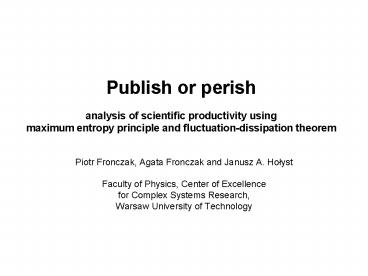Piotr Fronczak, Agata Fronczak and Janusz A' Holyst - PowerPoint PPT Presentation
1 / 18
Title:
Piotr Fronczak, Agata Fronczak and Janusz A' Holyst
Description:
Piotr Fronczak, Agata Fronczak and Janusz A. Holyst. Faculty of Physics, ... analysis of scientific ... fat-tailed (when the same cohort consists of mature ... – PowerPoint PPT presentation
Number of Views:124
Avg rating:3.0/5.0
Title: Piotr Fronczak, Agata Fronczak and Janusz A' Holyst
1
Publish or perish analysis of scientific
productivity using maximum entropy principle and
fluctuation-dissipation theorem
- Piotr Fronczak, Agata Fronczak and Janusz A.
Holyst - Faculty of Physics, Center of Excellence
- for Complex Systems Research,
- Warsaw University of Technology
2
publish-or-perish phenomenon
Evaluations of scientists depend on number of
papers, positions in lists of authors, and
journals impact factors. In Japan, Spain and
elsewhere, such assessments have reached
formulaic precision. But bureaucrats are not only
wholly responsible for these changes - we
scientists have enthusiastically colluded. What
began as someone elses measure has become our
(own) goal
P.A. Lawrence, The politics of publication,
Nature 422, 259 (2003).
3
publish-or-perish phenomenon
- Findings are sliced as thin as salami and
submitted to different - journals to produce more papers.
- The number of periodicals worldwide currently
stands at 169 000. - Fluid mechanics, as an example, has at least 250
journals published - in English.
Frequent publications allow to sustain ones
career, and are well seen when applying for
funds.
4
Our findings
- Using data retrieved from the INSPEC database, we
quantitatively analyze two syndromes of the
publish-or-perish phenomenon - continuous growth of rate of scientific
productivity - continuously decreasing percentage of those
scientists who stay in science for a long time.
5
INSPEC database
- over 3 million of authors
- period covered 1969-2004
- a few million of records indexing scientific
articles published world-wide in physics,
electrical engineering and electronics, computing
and information technology - each record consists of 14 fields (name, title,
year, classification codes, etc.). We have
retrieved only two of them authors name (with
initials) and publication year
6
Long-life scientists
From the database we have drawn long-life
scientists (i.e. scientists who were productive
for at least 18 years), and we have divided them
into the so-called T-cohorts, where T stands for
the initial year of ones scientific activity.
7
First syndrom of publish-or-perish phenomenon
Excluded region
8
Histograms of scientific productivity N(x t, T )
characterizing cohorts of long-life scientists,
who started to publish in a given year T 1975
or 1985, and ? t - T 6, 12, 18.
N(x t, T ) changes from almost exponential (when
a cohort contains young scientists) to clearly
fat-tailed (when the same cohort consists of
mature researchers).
9
In order to examine cohort differences we have
analysed how the average ?x? and the variance
?x2? - ?x?2 of the distribution N(x t, T )
depend on the cohort parameter T 1975, . . . ,
1987, and how they change over time t. We have
found the following relations
10
The above figures show that an average
representative of each cohort possesses an
acceleration parameter a, which is fixed during
the whole scientific career. The acceleration
parameter a increases with T, certifying that
younger scientists are better skilled to produce
more papers than their older colleagues at the
same point of the scientific career.
11
Theoretical approach to scientific productivity
Assumptions 1. The considered scientists are
exposed to the same external field (influence)
?(t, T), which forces (motivates) scientists to
publish an average number of publications ?x?(t,
T).
- 2. Probability distribution P(?) over a given
T-cohort at time t, where - ? y1, y2, . .
. , yn - stands for states of a single scientist, who
belongs to the considered cohort, maximizes the
Shannon entropy (maximum entropy principle by
Jaynes, 1957).
12
Theoretical approach to scientific productivity
Given the above assumptions one can show that
and the fluctuation-dissipation relation holds in
the considered systems, i.e. in T-cohorts.
13
Inserting previously found relations
into the fluctuation-dissipation relation one gets
where parameters a, b,A,B,C,D depend on T. We
have found values of the parameters from real
data.
14
Note the parameter ?(t,T) characterizes external
field acting on scientists. Your community puts
pressure on you to publish more and more
Small values of the field ?(t,T) correspond to
large productivity, and vice versa - large fields
?(t,T) induce small productivity
15
In order to survive younger (in terms of T)
scientists have to publish more than their older
colleagues at the same age. Publish or perish!
16
Density of states for scientific productivity
- Observed distribution of scientific productivity
P(xt,T) is not given by an exponential function
g(xt,T) density of states
17
Measured density of states from INSPEC data
18
Conclusions
Using methods of equilibrium statistical physics
we have attempted to provide a quantitative
approach to the publish-or-perish phenomenon,
which refers to the pressure to constantly
publish work in order to further or sustain ones
scientific career.
Analysis of scientific productivity using maximum
entropy principle and fluctuation-dissipation
theorem P. Fronczak, A. Fronczak, and J. A.
Holyst Phys. Rev. E 75, 026103 (2007)































